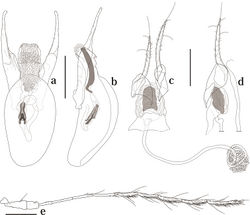Scaphicoma subflava
| Notice: | This page is derived from the original publication listed below, whose author(s) should always be credited. Further contributors may edit and improve the content of this page and, consequently, need to be credited as well (see page history). Any assessment of factual correctness requires a careful review of the original article as well as of subsequent contributions.
If you are uncertain whether your planned contribution is correct or not, we suggest that you use the associated discussion page instead of editing the page directly. This page should be cited as follows (rationale):
Citation formats to copy and paste
BibTeX: @article{Ogawa2014ZooKeys403, RIS/ Endnote: TY - JOUR Wikipedia/ Citizendium: <ref name="Ogawa2014ZooKeys403">{{Citation See also the citation download page at the journal. |
Ordo: Coleoptera
Familia: Staphylinidae
Genus: Scaphicoma
Name
Scaphicoma subflava Ogawa & Löbl sp. n. – Wikispecies link – ZooBank link – Pensoft Profile
Diagnosis
Most of body yellowish-brown. Body size relatively moderate. Antennomere XI about 1.6 times as long as VIII; IV and V each shorter than VI. Protarsomeres I–III and V each about two times as long as IV. Mesotarsomeres I about 1.2 times as long as II and III; V about 1.5 times as long as IV. Metatarsomeres I about 1.5 times as long as II and III; II and III each about 1.5 times as long as IV and V. Male sternite VII with middle of apical margin strongly concave. Parameres asymmetrical. Internal sac on basal portion covered with scale-like sclerites, and with pair of sclerites on apical portion. Bursa copulatrix sclerotized.
Description
Body, shining. Most of body including head, pronotum and elytra yellowish-brown, except for darkened mesoventrite (Fig. 1a). Antennae yellowish-brown, except of antennomeres VII–XI dark yellowish-brown. Head, pronotum and elytra sparsely and finely pubescent.
Head with interocular distance almost as eye width. Punctuation sparse and fine. Antennomeres I–VI with a few macrosetae, VII–XI covered with some microsetae; VI about two times as long as III; IV and V each shorter than VI; VII almost as VIII; XI about 1.6 times as long as VIII (Fig. 2e). Pronotum almost as wide as long, lateral keel invisible in dorsal view. Punctuation sparse and fine, as on head. Scutellum concealed.
Elytra longer than wide, widest at basal 1/6, gradually narrowed to apex, with minute serration at inner part of posterior margin. Punctuation coarser than on pronotum (Fig. 5e, f). Sutural striae extending outwards along basal margin to form basal striae, reaching humeral area and not joined with lateral striae.
Propygidium densely and finely punctuate. Pygidium sparsely and finely punctuate, slightly emarginated at apex.
Hypomeron finely punctuate. Lateral portion of mesoventrite coarsely and sparsely punctuate; medial portion finely and sparsely punctuate, with fine pubescence. Lateral portion of metaventrite from base to basal 1/3 sparsely and coarsely punctuate, with apical portion moderately concave. Mesocoxa almost six times as wide as space between them; mesocoxal area moderately broadened. Metepimeron almost as long as wide, with microsculpture. Metacoxa about eight times as wide as metacoxal process. Metanepisternum about six times as long as wide. Lateral portion of ventrite I from base to basal 1/3 densely and coarsely punctuate. Ventrite VI strongly pointed at apicomedian portion.
Meso- and metafemora with microsculpture, sparsely and coarsely punctuate. Protarsomeres I–III and V each about two times as long as IV. Mesotarsomeres I about 1.2 times as long as II and III; V about 1.5 times as long as IV. Metatarsomeres I about 1.5 times as long as II and III; II and III each about 1. 5 times as long as IV and V.
Male. Ventrite V strongly emarginated at apex. Protarsomeres I–III with tenent setae (Fig. 5b), enlarged. Aedeagus about 0.91 mm long; parameres asymmetrical; internal sac on basal portion covered with scale-like sclerites, and with a pair of sclerites (Fig. 2a).
Female. Ventrite V slightly emarginate or truncate. Protarsomeres I–III without tenent setae, not enlarged. Gonostylus elongate. Distal gonocoxite normal and elongate; vagina membranous, without robust sclerites; bursa copulatrix strongly sclerotized (Fig. 2c, d). Spermatheca as Fig. 2c.
Measurements
(n = 6). Length (PL+EL): 2.55–2.75 mm; width (PW, EW): 1.04–1.13 mm, 1.09–1.21 mm. HW: 0.55–0.58 mm. ID: 0.16–0.19 mm. PL/PW: 0.95–1.07. EL/EW:1.30–1.43. Approximate ratio of each antennal length (width) from base to apex as follows (n = 1): 1.7 (0.7): 0.9 (0.6): 1.0 (0.2): 1.6 (0.2): 1.5 (0.2): 1.9 (0.2): 1.5 (0.3): 1.5 (0.2): 1.7 (0.3): 1.9 (0.3): 2.5 (0.2).
Specimens examined
Holotype, 1 ♂, Mt. Tilongkabila (Gunung Tilongkabila), N. Sulawesi, alt. ca. 800m, 0°34'28.52N, 123°11'30.61E, 8. VI. 2012, R. Ogawa leg. (MZBI); Paratypes, 2♂2♀, Same data above (EUMJ); 1♂, Mt. Tilongkabila (Gunung Tilongkabila), N. Sulawesi, alt. ca. 800–1300 m, 0°34'28.52N, 0°35'18.14N, 123°11'30.61E, 123°13'22.71E, 9. VI. 2012, R. Ogawa leg. (HUOI); 1♂, Palu, Palopo, C. Sulawesi, 25–27. VIII. 1990, A. Riedel leg. (MHNG).
Distribution
Indonesia: northern and central Sulawesi.
Etymology
This specific name is the Latin subflava adjective meaning somewhat yellowish.
Remarks
This species was illustrated in Leschen and Lobl (2005)[1], thought unidentified. It is very similar to the Javanese Scaphicoma pallens (Achard, 1921) by the body color and the shapes of male genitalia, but it is easily distinguished by the distinctive male genitalia with internal sac bearing sclerites.
Original Description
- Ogawa, R; Löbl, I; Maeto, K; 2014: Three new species of the genus Scaphicoma Motschulsky, 1863 (Coleoptera, Staphylinidae, Scaphidiinae) from Northern Sulawesi, Indonesia ZooKeys, 403: 1-13. doi
Other References
- ↑ Leschen R, Löbl I (2005) Phylogeny and classification of Scaphisomatini (Staphylinidae: Scaphidiinae) with notes on mycophagy, termitophily and functional morphology. Coleopterists Society Monographs 3: 1-63. doi: 10.1649/0010-065X(2005)059[0001:PACOSS]2.0.CO;2
Images
|


